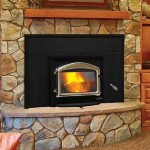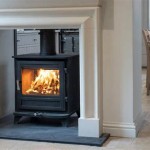Propane Fireplace Inserts: A Comprehensive Guide
Propane fireplace inserts are a popular heating solution for homeowners seeking efficient, convenient, and aesthetically pleasing alternatives to traditional wood-burning fireplaces. These inserts transform existing masonry or factory-built fireplaces into modern, clean-burning appliances. This article provides a comprehensive overview of propane fireplace inserts, covering their benefits, different types, installation considerations, maintenance requirements, and factors to consider when choosing the right model.
A propane fireplace insert is essentially a self-contained heating appliance designed to fit inside an existing fireplace opening. It operates by burning propane gas, which is a readily available and relatively clean-burning fuel. The insert typically includes a burner, a firebox, a venting system, and decorative elements like artificial logs or glass beads. Unlike open-hearth fireplaces, which lose a significant amount of heat up the chimney, propane inserts are designed to efficiently heat the surrounding room. They achieve this through a closed combustion system and often incorporate a blower fan to circulate the heated air.
The key advantage of a propane fireplace insert lies in its efficiency. Open-hearth fireplaces are notoriously inefficient, with as much as 90% of the heat produced being lost up the chimney. Propane inserts, on the other hand, can achieve efficiencies of 70% to 85% or even higher, depending on the model. This translates to lower heating bills and a reduced environmental impact. Furthermore, propane inserts offer greater control over the heating process. Many models feature thermostats and remote controls, allowing users to precisely regulate the temperature and operate the fireplace from the comfort of their couch.
Beyond their efficiency and convenience, propane fireplace inserts offer aesthetic benefits. They are available in a wide range of styles and finishes, allowing homeowners to match the insert to their existing décor. Options include traditional log sets, contemporary glass beads, and various metal finishes for the surround. This versatility allows for a seamless integration into the living space, enhancing the overall ambiance of the room. Furthermore, propane inserts eliminate the need for storing and handling firewood, reducing mess and labor.
Understanding the Benefits of Propane Fireplace Inserts
The popularity of propane fireplace inserts stems from a multitude of advantages they offer over traditional fireplaces and other heating solutions. These advantages can be broadly categorized into efficiency, convenience, and aesthetics.
Efficiency: As mentioned previously, the higher efficiency of propane fireplace inserts is a significant selling point. Traditional fireplaces are inefficient because they draw air from the room for combustion, which then escapes up the chimney along with the heat. Propane inserts, with their closed combustion systems, minimize this heat loss. They also often include a blower fan to circulate the heated air more effectively, ensuring that the warmth is distributed throughout the room rather than escaping up the chimney. The result is a more comfortable living space and lower heating costs, particularly during colder months. The use of propane, while a fossil fuel, burns cleaner than wood, reducing particulate emissions and contributing to better air quality.
Convenience: The convenience factor associated with propane fireplace inserts is undeniable. Unlike wood-burning fireplaces, there is no need to chop, stack, or store firewood. Starting a fire is as simple as pressing a button or turning a dial. Many models are equipped with remote controls and thermostats, allowing users to adjust the flame height and temperature from a distance. This level of control makes it easy to maintain a comfortable and consistent room temperature. Furthermore, propane inserts require minimal maintenance compared to wood-burning fireplaces. There is no ash to clean up, and the venting system generally requires less frequent cleaning.
Aesthetics: Propane fireplace inserts offer a wide range of aesthetic options to suit different tastes and home décor styles. Homeowners can choose from a variety of log sets, ranging from realistic-looking replicas to more stylized designs. Alternatively, glass beads or fire glass provide a modern and contemporary look. Surrounds, which frame the insert, are available in various materials and finishes, including painted metal, cast iron, and stone. This flexibility allows homeowners to customize the look of the fireplace to match their existing décor or create a new focal point in the room. The visual appeal of a propane fireplace insert can significantly enhance the ambiance and value of a home.
Types of Propane Fireplace Inserts
Propane fireplace inserts are not all created equal. They vary in terms of venting requirements, heating capacity, and features. Understanding the different types available is crucial for selecting the right insert for specific needs and circumstances.
Direct Vent Inserts: Direct vent inserts are the most common and generally considered the safest type of propane fireplace insert. They draw combustion air from outside the home and vent exhaust gases directly outside through a sealed system. This eliminates the risk of indoor air contamination and ensures efficient combustion. Direct vent inserts typically require a flexible vent pipe to be run up the existing chimney, or, in some cases, through an exterior wall. They offer the most flexibility in terms of installation locations, as they do not rely on existing chimney draft.
Vent-Free Inserts: Vent-free, or ventless, propane fireplace inserts do not require an external venting system. They burn propane very cleanly, with minimal emissions. However, they are equipped with oxygen depletion sensors (ODS) that automatically shut off the insert if the oxygen level in the room drops too low. While vent-free inserts offer greater installation flexibility, they are subject to stricter regulations and may not be permitted in all jurisdictions. It is crucial to check local building codes before installing a vent-free insert. Furthermore, vent-free inserts should only be used in well-ventilated rooms, and they are generally not recommended for individuals with respiratory problems.
B-Vent Inserts: B-vent inserts utilize the existing chimney for venting. They draw combustion air from the room and vent exhaust gases up the chimney through a thin-walled metal pipe (B-vent). B-vent inserts require a properly functioning chimney with adequate draft to ensure proper venting. They are generally less efficient than direct vent inserts, as some heat can be lost up the chimney. B-vent inserts are typically used in situations where a direct vent system is not feasible or desirable.
When selecting a propane fireplace insert, it is important to consider the venting requirements, heating capacity (measured in BTU – British Thermal Units), the size of the room to be heated, and any specific features desired, such as a remote control, thermostat, or blower fan.
Installation and Maintenance Considerations
The proper installation and maintenance of a propane fireplace insert are crucial for ensuring safe and efficient operation. Incorrect installation can lead to safety hazards, such as gas leaks or carbon monoxide poisoning. Neglecting maintenance can reduce the lifespan of the insert and compromise its performance.
Installation: It is highly recommended to have a qualified and licensed professional install a propane fireplace insert. A professional installer will be familiar with local building codes and safety regulations and will have the necessary tools and expertise to ensure a safe and proper installation. The installation process typically involves inspecting the existing fireplace and chimney, running the vent pipe, connecting the gas line, and testing the system for leaks. The installer will also ensure that the insert is properly sealed and that the surround is securely attached.
Before installation, it is essential to have the existing chimney inspected and cleaned by a certified chimney sweep. This will ensure that the chimney is free of obstructions and that it is structurally sound. If the chimney is damaged or deteriorated, it may need to be repaired or relined before installing the insert. In the case of direct vent inserts, the vent pipe must be properly sized and installed according to the manufacturer's instructions. Any gaps or leaks in the vent system can compromise its effectiveness and potentially lead to dangerous exhaust gases entering the home.
Maintenance: Regular maintenance is essential for keeping a propane fireplace insert in good working order. The frequency of maintenance will depend on the frequency of use and the specific model of insert. However, some general maintenance tasks should be performed on a regular basis. These include:
- Cleaning the glass: The glass door of the insert should be cleaned periodically to remove soot and buildup. Use a commercially available fireplace glass cleaner or a mixture of vinegar and water.
- Inspecting the burner: The burner should be inspected regularly for dirt, debris, and corrosion. Clean the burner with a soft brush or vacuum cleaner.
- Checking the vent system: The vent system should be inspected annually for leaks, obstructions, and corrosion. It is recommended to have a professional chimney sweep inspect the vent system every year or two.
- Replacing the pilot light: The pilot light may need to be replaced periodically. Follow the manufacturer's instructions for replacing the pilot light.
- Testing the oxygen depletion sensor (ODS): For vent-free inserts, the ODS should be tested regularly to ensure that it is functioning properly.
By following these installation and maintenance guidelines, homeowners can ensure that their propane fireplace insert operates safely and efficiently for many years.

Gas Fireplace Insert Propane Regency Vermont Castings Napoleon

Enviro E Series Gas Or Propane Insert Fireplace Fireplaces By Cameron

Propane Fireplace Inserts Gas Log Sets Tunkhannock Pa Ace Robbins

Fireplace Insert Guide Fireplaces Direct Learning Center

Bluegrass Living 34 In W 32000 Btu Black Vent Free Dual Burner Gas Fireplace Insert And Remote The Inserts Department At Com

Gas Propane Fireplace Inserts

Gas Fireplace Inserts Napoleon Fireplaces

Inserts Gas Kingsman Vented Fireplace Insert Millivolt Propane Vfi30lp

Propane Gas Fireplace Inserts Delivered Installed In Ct Works

Inserts Gas Kingsman Direct Vent Fireplace Insert Millivolt Propane Idv36lp
Related Posts








